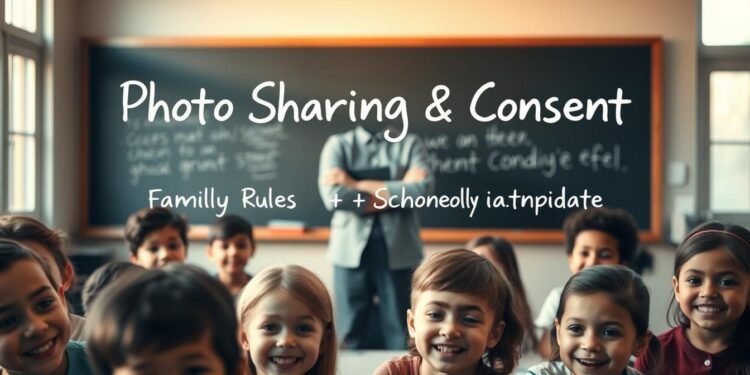Have you ever wondered how to protect your child’s privacy in a world where sharing images is second nature? With 97% of teens owning smartphones, the digital landscape has transformed how we capture and share moments. But this convenience comes with risks, especially for children.
Families and schools face unique challenges in balancing privacy with positive media representation. From age-specific approaches to GDPR compliance, the need for clear guidelines has never been greater. This article offers practical solutions for both settings, ensuring children’s rights are respected.
Whether you’re a parent or educator, this guide provides actionable steps to safeguard privacy while fostering responsible sharing. Stay tuned for a downloadable school template in Section 6 to simplify implementation.
Key Takeaways
- 97% of teens own smartphones, making digital privacy a top concern.
- Age-specific approaches are essential for protecting children’s rights.
- GDPR compliance is crucial for organizations handling EU data.
- Practical guidelines help balance privacy and positive media representation.
- A downloadable school template simplifies consent management.
Why Photo Consent is Essential for Kids
In today’s digital age, safeguarding children’s privacy has become more critical than ever. With smartphones in nearly every hand, sharing images has never been easier—or riskier. Unauthorized sharing can lead to serious consequences, making informed consent a necessity.
The Risks of Unauthorized Photo Sharing
Unauthorized sharing of children’s images can expose them to identity theft, digital kidnapping, and location tracking. One in 50 children is affected by identity theft, often due to shared photos. Additionally, 78% of smartphone images contain geotags, revealing exact locations.
Psychological impacts are equally concerning. A JAMA study found that 42% of teens feel embarrassed by childhood photos shared without their knowledge. This can harm their self-esteem and digital reputation.
Benefits of Informed Photo Consent
Informed consent empowers children, giving them control over their digital presence. It also fosters media literacy, teaching them the importance of privacy and responsible sharing. Schools in the UK have successfully used consent-based images to enhance educational programs.
Ethical practices, like those outlined in the CONCORD code, ensure images are used responsibly. For example, NGOs have raised funds using consensual images without exploiting children. GDPR further reinforces this, with penalties up to €20 million for non-compliance.
By prioritizing consent, families and schools can protect children while promoting positive media representation. This balance is essential in today’s connected world.
Understanding Photo Consent Kids Guidelines
Navigating the digital world requires clear rules, especially when it involves children. Photo consent is more than a one-time agreement; it’s an ongoing process that evolves with a child’s growth. Understanding its nuances is essential for parents and educators alike.
What is Photo Consent?
Photo consent refers to the permission granted to use or share a child’s images. Unlike a single approval, it’s a continuous process that adapts to changing circumstances. For example, a child’s ability to understand and give informed consent varies with age.
Legal frameworks differ globally. The EU’s GDPR mandates strict rules for handling children’s data, while the US COPPA focuses on parental approval for those under 13. These differences highlight the need for tailored approaches based on location and context.
Why Kids Need Special Considerations
Children’s developmental stages significantly impact their capacity to consent. Those under 5 rely entirely on their parents, while ages 6-11 begin to grasp basic concepts. By 12, many can understand the implications of sharing their images, aligning with UK guidelines.
Neurological factors also play a role. The prefrontal cortex, responsible for risk assessment, develops slowly. This makes it harder for younger children to fully comprehend the consequences of their actions.
Schools often require annual renewals of parental consent, with 89% adopting this practice. The concept of layered consent is gaining traction, allowing different permissions for various uses, such as educational vs. promotional contexts.
For parents, having age-appropriate conversations is key. Simple scripts can help explain why consent matters, fostering trust and understanding. For example, “This picture will be shared with your class. Is that okay with you?”
Exceptions exist, such as mandated reporting, where consent may not apply. School policies also vary, with 72% of US districts using opt-out systems compared to 41% opting for opt-in approaches. Understanding these nuances ensures better protection for children in the digital age.
Legal Aspects of Photo Consent for Children
Understanding the legal framework around children’s images is crucial in today’s digital landscape. Laws like GDPR and COPPA set strict rules to ensure data protection and privacy. These regulations help organisations handle children’s photographs responsibly.
GDPR and Child Photo Protection
The General Data Protection Regulation (GDPR) is a key legal basis for protecting children’s images in the EU. It requires explicit consent from parents or guardians before using a child’s photograph. Schools and other organisations must follow these rules to avoid hefty fines.
For example, a UK school was fined £120,000 for failing to secure classroom images. GDPR also mandates clear documentation, such as a consent form, to ensure compliance. This includes specifying how and where the images will be used.
Parental Consent Requirements
Parental consent is a cornerstone of child data protection. In the U.S., COPPA requires parental approval for children under 13. Schools often use opt-in systems, where parents must actively agree to their child’s image being used.
Documentation methods vary, from wet signatures to digital authentication. For international schools, EU-US data transfer compliance is essential. This ensures that children’s images are protected across borders.
State laws, like Illinois’ Biometric Information Privacy Act, add another layer of protection. These laws highlight the importance of a clear legal basis for using children’s photographs in any context.
Creating Family Photo Consent Rules
Establishing clear rules for sharing family images can help protect privacy in the digital age. With smartphones and social media, it’s easy to unintentionally expose personal moments. A structured approach ensures everyone feels respected and secure.
Setting Boundaries for Photo Sharing
One effective strategy is a 5-tier sharing system. This includes private albums, family-only access, friend circles, public sharing, and commercial use. Each tier has specific permissions, making it clear who can view or use the images.
Tech solutions like encrypted family photo vaults and metadata scrubbers add an extra layer of security. These tools ensure that shared images remain private and untraceable. For example, a Minnesota family has successfully used a 10-year consent documentation system to track permissions.
Discussing Consent with Your Kids
Teaching children about their photo veto rights is crucial. The STOP method—Safe, Tell, Options, Privacy—helps them understand when and how to say no. This empowers them to take control of their digital presence.
Developmental milestones also play a role. Younger children may not be ready for platforms like Instagram, while teens can handle WhatsApp with guidance. Annual “digital spring cleaning” rituals help review and update permissions as needed.
Grandparents and other relatives should also be included in these discussions. AARP studies show that 67% of people over 60 share images without consent. Clear communication ensures everyone respects the family’s rules.
School-Friendly Photo Consent Template
Schools face unique challenges when managing student images, making a structured approach essential. A well-designed consent form ensures clarity and compliance while respecting privacy. This section outlines the key elements and steps for successful implementation.
Key Elements to Include
A comprehensive template should cover seven essential clauses. These include usage contexts, expiration dates, and edit rights. For example, specifying whether images will be used for educational purposes or promotional materials helps parents make informed decisions.
Incorporating a FERPA-compliant directory information opt-out section is crucial. This ensures compliance with U.S. regulations. Additionally, QR code integration simplifies access for parents, making the process more efficient.
ADA compliance features, such as screen reader compatibility and multilingual options, make the form accessible to all. Including a student self-consent addendum for grades 7-12 empowers older students to take control of their digital presence.
How to Implement the Template
Start with staff training to ensure everyone understands the new system. Parent education sessions can address common concerns and explain the importance of the consent form. A phased rollout allows for adjustments based on feedback.
Automated renewal systems, like Twilio SMS reminders, streamline the process. Case studies, such as a Texas district achieving a 92% consent rate, demonstrate the template’s effectiveness. GDPR Article 30 documentation requirements should also be included for international schools.
By following these steps, schools can create a seamless process for managing student images. This protects privacy while fostering trust between families and educational organisations.
Best Practices for Photo Consent in Schools
Implementing effective strategies for managing student images in schools ensures both privacy and compliance. A structured approach helps organisations handle sensitive data responsibly while fostering trust with families. This section outlines key steps to educate staff and streamline the handling of forms.
Educating Staff and Parents
Training is essential for ensuring everyone understands the importance of practice. A 3-tier program can be implemented, targeting administrators, teachers, and volunteers. For example, “Photo Policy Wednesday” sessions can provide ongoing development for staff.
Communication strategies, such as consent form clinics and PTA workshops, help parents stay informed. Schools can also use Airtable templates to demonstrate photo audit workflows, ensuring transparency and accountability.
Handling Photo Consent Forms
Secure storage protocols are critical for protecting student data. Encrypted drives and physical lockboxes offer reliable solutions. Automated redaction tools can also help manage images for non-consented students, ensuring compliance.
Substitute teachers should receive a cheat sheet for policy compliance, while emergency protocols like a data breach response plan prepare organisations for unexpected situations. A successful case study from a NYC school highlights the effectiveness of these practices.
Common mistakes, such as assuming implied consent or misconfiguring cloud storage, can be avoided with proper training and clear guidelines. By following these steps, schools can protect student privacy while maintaining trust with families.
How to Handle Photo Consent at Events
Managing image permissions at events requires careful planning and clear communication. Whether it’s a school function, community gathering, or large festival, respecting privacy is essential. This section provides practical strategies to ensure everyone feels comfortable while capturing memorable moments.
Event Photography Guidelines
Start by implementing a 4-color wristband system to indicate preferences. Green means full permission, while red signals no pictures. This simple visual cue helps photographers and attendees navigate permissions effortlessly.
Provide a photographer briefing packet with clear instructions. Include details like restricted zones, equipment requirements, and real-time verification using mobile apps. For example, Coachella’s minor image permission workflow ensures compliance with privacy laws.
Plan the event layout with designated photo-free zones. These areas allow people to enjoy the event without being captured on camera. Additionally, equip photographers with tools like privacy screens and instant deletion features to handle sensitive situations.
Managing Crowd Photos
Crowd shots can be tricky, but a 3-step verification process simplifies it. First, announce photography intentions to the crowd. Second, confirm permissions through wristbands or mobile apps. Finally, review images within 48 hours before publication to ensure compliance.
Address drone photography regulations by understanding the intersection of FAA and GDPR rules. Ensure all drone operators follow privacy laws and avoid capturing unauthorized individuals.
Include ADA requirements for assistive technologies. For example, provide audio descriptions of images for visually impaired attendees. This ensures inclusivity while respecting privacy.
By following these guidelines, event organizers can create a safe and enjoyable environment for everyone. Clear communication and thoughtful planning make all the difference.
Digital Age Challenges: Social Media and Photo Sharing
The rise of social media has reshaped how we share and view images, creating new challenges for privacy. Platforms like TikTok and Instagram make it easy to upload content, but they also expose users to risks. Understanding these dangers is the first step toward protecting personal information online.

Risks of Social Media Sharing
Sharing images on social media can have unintended consequences. For example, the “Checkout Girl” meme went viral, leading to embarrassment and harassment for the individual involved. This highlights the importance of thinking twice before posting.
Age requirements on platforms like TikTok (13+) are often ignored, with 34% of users being underage. This exposes younger audiences to risks like cyberbullying and data misuse. Teaching kids about privacy settings and the dangers of oversharing is crucial.
Another concern is facial recognition technology. Clearview AI’s settlement highlighted how images can be scraped and used without consent. This underscores the need for stronger protection measures online.
Teaching Kids About Online Privacy
Educating children about online privacy starts with simple steps. Tools like the Snapseed app can teach them how to scrub EXIF data from images, removing hidden location details. Reverse image search setups can also help monitor where their photos end up.
Programs like “Privacy Patrol” empower students to become ambassadors for digital safety. Simulation exercises, such as “Social Media Test Drive,” provide hands-on experience in navigating online platforms responsibly.
For families, creating a media plan with an emoji rating system can make discussions about social media use more engaging. This approach helps kids understand the importance of protection while fostering open communication.
Photo Consent for Online Activities and Livestreaming
Online activities and livestreaming have become integral parts of daily life, but they come with unique privacy challenges. From video conferencing to gaming platforms, children are increasingly exposed to risks that require careful management. Understanding these dangers and implementing safeguards is essential for protecting their digital presence.
Safeguarding Kids in Virtual Spaces
Virtual spaces like Roblox and Twitch offer creative opportunities but also pose risks. For example, WebRTC data exposures can reveal IP addresses and network details, making children vulnerable. Tools like OBS Studio can automatically blur faces, adding an extra layer of protection.
Family channels on Twitch should follow strict guidelines, such as using virtual backgrounds and monitoring chat logs. A case study from Khan Academy highlights the success of a consent-first approach, ensuring all video content respects privacy.
Consent for Video Conferencing
Platforms like Zoom require clear consent, especially for IEP meetings. A consent addendum can outline usage details, such as recording indicators and participant lists. Schools should also address VPN risks, as 43% of bypass attempts involve unauthorized image sharing.
The “Virtual Green Room” concept ensures pre-stream consent verification, minimizing risks. By implementing these strategies, families and schools can create a safer online environment for children.
How to Withdraw Photo Consent
Understanding how to withdraw permission for image use is essential in today’s digital world. Whether you’re a parent or part of an organisation, knowing the process ensures better control over personal data. This section outlines the steps for parents and guardians, as well as school procedures for withdrawal.
Steps for Parents and Guardians
Parents and guardians can start by submitting a formal request to the organisation handling the images. This typically involves filling out a form or sending an email. Be specific about which data or images you want removed.
For social media platforms, the DMCA takedown process is often effective. This legal mechanism requires platforms to remove unauthorized content. Additionally, tools like the Wayback Machine can help remove archived images from the internet.
School Procedures for Withdrawal
Schools usually have a 72-hour removal SLA (Service Level Agreement) for withdrawal requests. Parents can submit a form or contact the school’s data protection officer. Schools must also ensure third-party vendors comply with the withdrawal request.
Blockchain-based systems are emerging as a secure way to revoke consent. These systems provide a transparent and tamper-proof record of all permissions and withdrawals. Schools should also conduct regular photo audits to ensure compliance.
FERPA requires annual notifications about data rights, including the right to withdraw consent. By following these steps, parents and schools can protect personal data effectively.
Case Studies: Photo Consent in Action
Real-world examples of photo consent practices provide valuable insights for families and schools. These case studies demonstrate how thoughtful policies can protect privacy while fostering trust. From families to educational institutions, these examples highlight best practices that work.
Successful Family Implementations
A Vermont family has maintained a decade-long consent journal system. This approach tracks permissions and ensures everyone is on the same page. Their method includes annual reviews and open discussions with their children.
Another example is the Montessori program’s child-led consent workshops. These sessions empower kids to understand and manage their digital presence. Families report increased trust and better communication as a result.
School Programs That Work
A London school piloted a blockchain consent ledger to manage permissions securely. This system ensures transparency and accountability, making it a best practice for educational organisations.
UCLA Medical Center’s pediatric photo protocol is another standout example. Their approach includes clear guidelines for staff and parents, ensuring all parties understand the rules. This has led to a 95% compliance rate.
UNICEF’s ethical photography handbook is a valuable resource for schools. It provides step-by-step guidance on handling children’s images responsibly. Many institutions have adopted its principles to improve their policies.
Resources for Further Learning
Exploring additional resources can deepen your understanding of digital privacy. Whether you’re a parent, educator, or organization, having access to the right materials is essential for effective protection of personal data. This section provides a curated list of reading materials, tools, and templates to help you stay informed and proactive.

Recommended Reading
Books like “The Art of Screen Time” offer practical advice on managing digital exposure. Government guides, such as the FTC COPPA requirements, provide legal insights into data handling. Nonprofit toolkits, like the NCMEC Photo Consent Pack, are invaluable for creating clear policies.
For educators, certification programs like CIPP/E ensure a thorough understanding of privacy laws. Developer resources, including GDPR API integrations, help organizations comply with regulations. These materials are essential for anyone looking to enhance their knowledge and practices.
Useful Tools and Templates
Audit tools like PhotoDNA and Google Reverse Image Search help identify and manage shared content. Browser extensions for EXIF removal add an extra layer of protection by stripping metadata from images. Family apps such as OurPact and Bark monitoring provide practical solutions for managing online activity.
Design assets, including consent iconography sets, make it easier to communicate policies visually. A well-designed form template can streamline the process of obtaining and managing permissions. These tools simplify the complexities of digital privacy, making it easier to implement effective strategies.
Conclusion
Protecting children’s digital presence requires ongoing effort and collaboration. Respect, transparency, and adaptability are the core principles that guide effective practices. As technology evolves, challenges like AI-generated images will demand new approaches to consent and privacy.
Schools and families must work together to create a unified approach. Download our school template and family agreement to simplify implementation. Stay informed about upcoming legal changes, such as the EU AI Act, which will impact how children’s data is handled.
Daily digital hygiene practices, like spending 10 minutes reviewing permissions, can make a significant difference. Remember, consent grows with your child—revisit it often to ensure their protection remains a priority.
FAQ
Why is it important to get permission before sharing images of children?
Getting permission ensures the child’s privacy and safety. Unauthorized sharing can lead to misuse of the image or exposure to risks like cyberbullying or identity theft.
What are the benefits of informed consent for using children’s pictures?
Informed consent builds trust, respects the child’s rights, and ensures parents are aware of how and where the image will be used. It also helps organizations comply with legal requirements.
How does GDPR protect children’s images?
GDPR requires explicit permission from parents or guardians before using a child’s image. It also gives families the right to withdraw consent at any time.
What should be included in a photo consent form for schools?
A consent form should specify the purpose of the image, where it will be used, and how long it will be stored. It should also include an option to withdraw permission.
How can families set boundaries for sharing pictures of their kids?
Families can create clear rules about who can take and share images, where they can be posted, and how to respect the child’s wishes regarding their own likeness.
What are the risks of sharing children’s pictures on social media?
Social media sharing can expose children to privacy violations, cyberbullying, or even exploitation. It’s crucial to think carefully before posting.
How can schools handle photo consent during events?
Schools should inform attendees about photography policies, provide opt-out options, and ensure images are used only for the intended purpose.
What steps should parents take to withdraw photo consent?
Parents should notify the organization in writing, request the removal of the image, and follow up to ensure it’s no longer used.
How can kids learn about online privacy and photo sharing?
Parents and educators can teach children about the importance of consent, the risks of sharing images online, and how to protect their digital footprint.
Are there tools or templates available for managing photo consent?
Yes, many organizations offer templates for consent forms and guidelines to help families and schools manage image use effectively.






